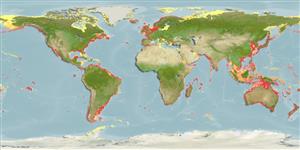Common names from other countries
Environment: milieu / climate zone / depth range / distribution range
экология
; пределы глубины 0 - 80 m (Ref. 1603). Tropical; 68°N - 76°S, 180°W - 180°E
Circumglobal.
Length at first maturity / Size / Вес / Возраст
Maturity: Lm ? range ? - ? cm Max length : 0.1 cm TL самец/пол неопределен; (Ref. 2226)
Assumed maximum length of zooids from Ref. 2226. Found also on dead corals. Attached to hard substrata (Ref. 1603); from low water level (Ref. 226) to depth of about 80 m (Ref. 1603); occurs in mangrove ponds (Ref. 1758). Colonial (Ref. 415).
Life cycle and mating behavior
половая зрелость | размножение | нерест | икра | Fecundity | личинки
Members of the class Ascidiacea are hermaphroditic; both cross- and self-fertilization is typical. Life cycle: Eggs develop into lecithotrophic larva before metamorphosing into benthic adults.
Основная ссылка
ссылки | координатор | соавторы
Sanamyan, K. and D. Schories. 2004. (Ref. 3379)
Статус Красного Списка МСОП (Ref. 130435)
Статус СИТЕС (Ref. 108899)
Not Evaluated
Not Evaluated
Использование человеком
| FishSource |
инструменты
дополнительная информация
Возраст/РазмерыростЗависимость между длиной и массой телаЗависимость между длинамиморфологияличинкичисленность
ресурсы в Интернет
Estimates based on models
Preferred temperature
(Ref.
115969): 7.3 - 27.9, mean 18.3 (based on 3200 cells).
Уязвимость
Low vulnerability (10 of 100).
Категория цены
Unknown.
